Ideas — For small and medium stations
The station and station approach are combined in a green pedestrian bridge that crosses the railway line creating a community garden close to the town. The bridge will serve three functions: it will link the station to the towns’ centre (many stations in small towns are outside of the centre). It makes crossing the railway line safe for pedestrians and it allows wildlife and flowers to cross.

The station will be placed underneath the bridge and the remaining space underneath the bridge will be used as offices and community services: just like the space underneath the traditional railway arches has been the home to small businesses and start-ups and a place of urban regeneration. The ends of both sides of the bridge will be used as bicycle storage. In the station hub there is space for amazon pick up points and cash machines together with the ticket selling machines.
The bridge can come in different widths, depending on the size of the town and can have stairs at one or both ends if there is no space for the full bridge at the specific station.
On top of the bridge we propose a series of ‘pavilions’. These can be designed as part of the station, but also by local artists and architects to make the station recognisable for travellers. The pavilions can house community cafés, food distribution centres/offices or consultancy rooms.
The proposal uses the traditional function of the railway arches as places of regeneration while making them as a link between the station and the towns. The proposed structure is a series of timber arches that will support a CLT slab. The CLT would be dimensioned in such a way that it will be easy to expand the bridge and add pavilions to it. Rain water will be collected and reused to water the plants on the bridge which will also use hydroponic technology.
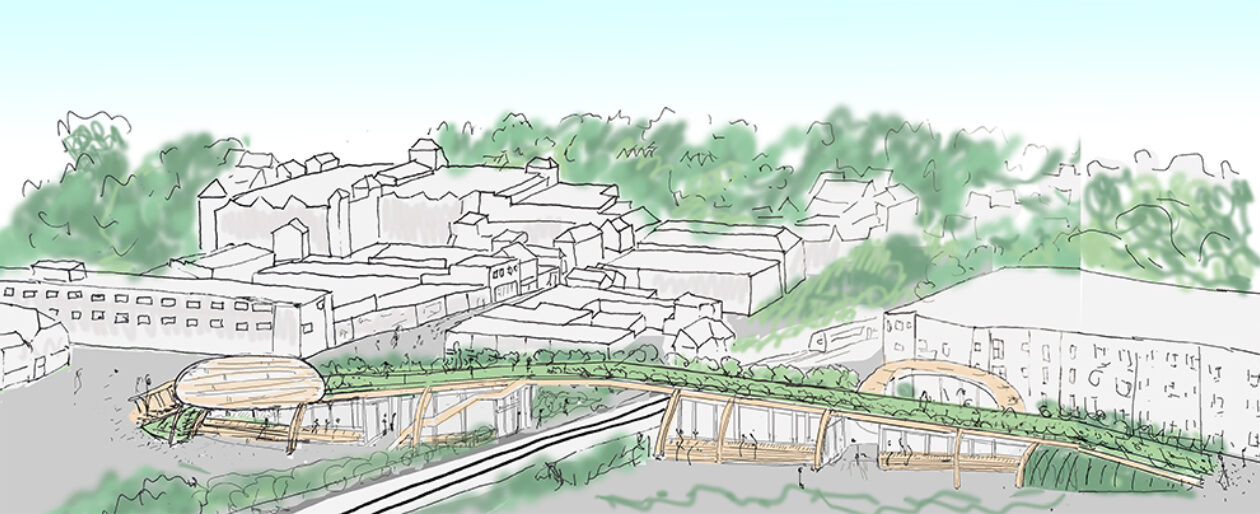
The Perspex Dolls’ House
This Perspex dolls’ house is an analysis of the traditional dolls’ house and breaks it up into components.
December 2020
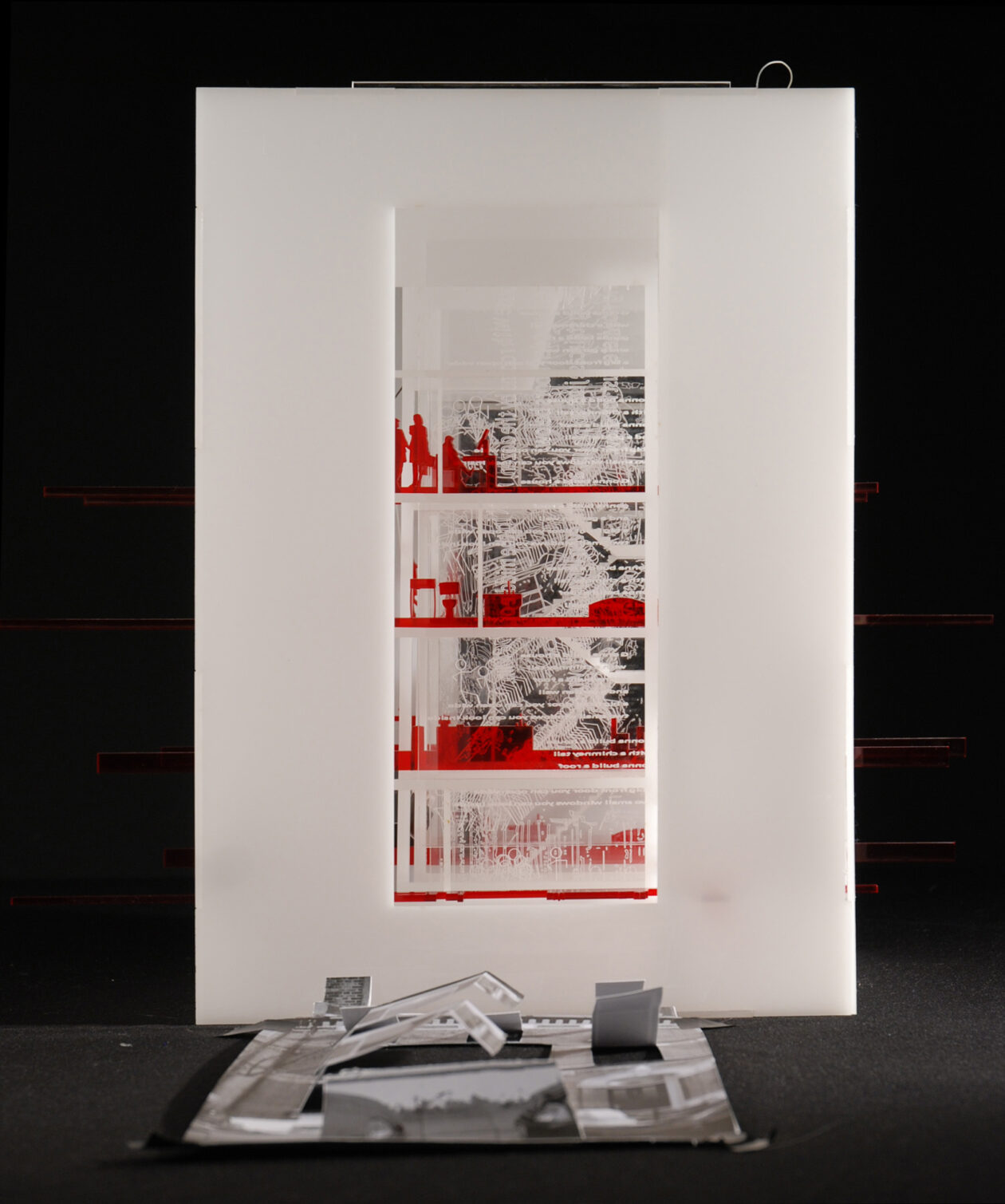
In the traditional dolls’ house objects are assembled in a room, or box. In the dolls’ house of Petronella Oortman, still visible in the Rijksmuseum in Amsterdam over 700 objects were displayed in nine boxes. All objects were made to scale.
The interior of the Perspex dolls’ house can be compared to a theatre. The contents of the house are reduced to a series of tableaux; Furniture, Bathrooms, Kitchens, wallpaper and configurations of prototypical people are composed on strips and slide through the house and are made of Perspex.
A series of etched backdrops depict moods and ideas: movement, thoughts and poems. These drop down through slots in the top of the box.
Personal photographs, which bring together space, actions and personal memories are engraved in timber, perhaps a more living material than Perspex which stands, in this case, for the generic and impersonal. The scale of the components doesn’t correspond with the real scale of the events but of the memory it takes up. So photographs of ‘important, or unimportant events’ are burned on timber cut outs.
A picture of the façade is printed on paper and can be stuck to the front of the box to give the house an address. The façade has not been important for the interior of the dolls house. The early Dutch dolls houses didn’t have a façade. In discussions on the home and the house, activities and content are always spoken of in terms of interior, not the exterior.
The terraced house perhaps shows how many people move through a house over time. Many terraced houses are over 100 years old. In each house people come and go with or without children, furniture and their own rules to occupy the house. What makes the house a home is the combination of the generic, but vital elements of the home so people can create their personal memories. These can take place anywhere in the home, but the event in combination with the place where it took place and what took place create for occupants the geography of the home.
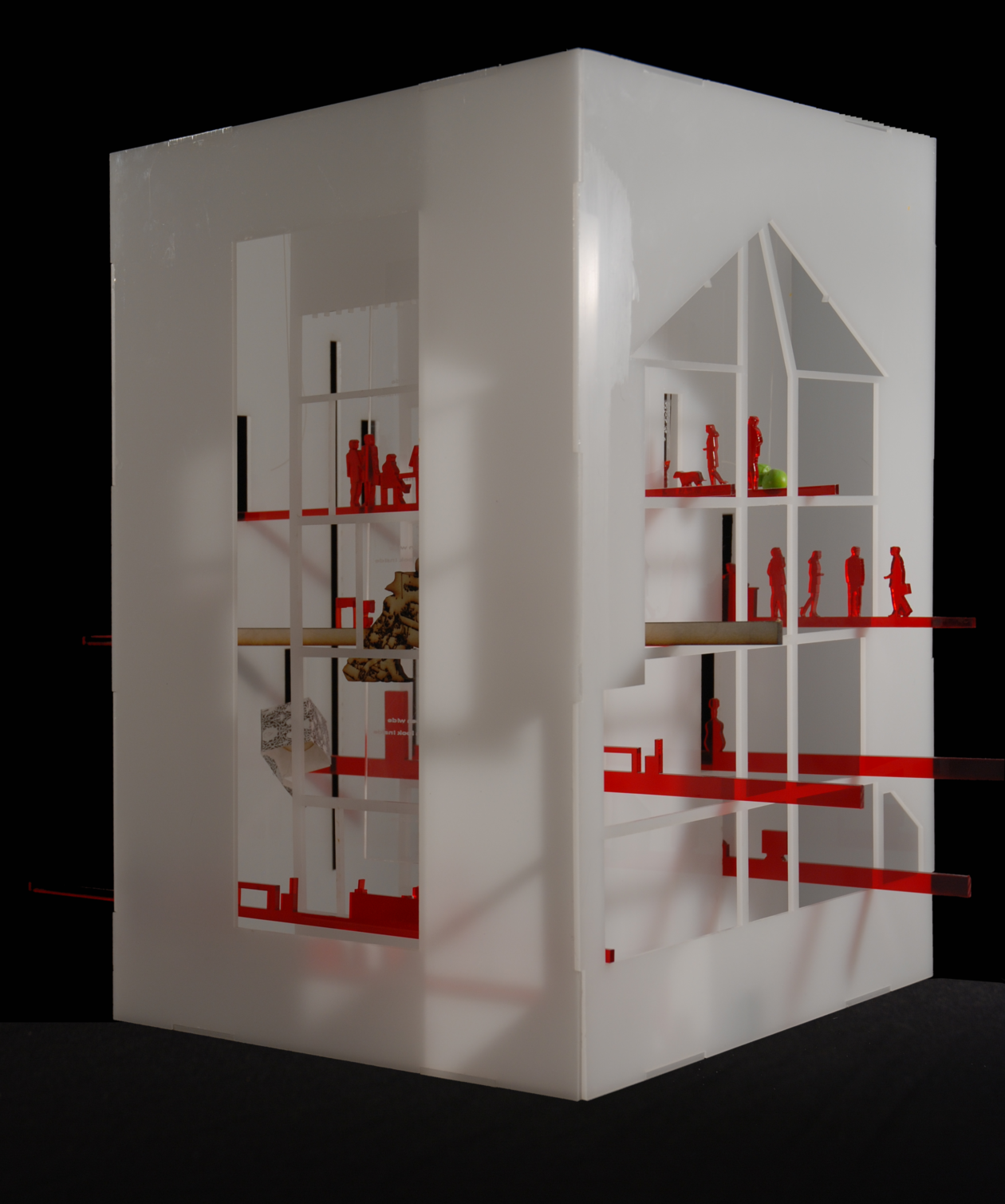
What if we couldn’t see the building on a site? Let’s make them invisible through dressing them in cloaks of greenery. Like the mirror houses in Sweden, where the green is reflected everywhere and seem invisible and yet are very obviously made of glass when they reflect the sun, or when the birds fly into them (observed by Jennifer Frewen). The house should be the tree perhaps.
The trees should take preference with the landscape, and birds and their nests, since we are treading on their territory, rather than the other way around. Why do we allow nature to be draped around the house as another commodity, just enough to balance it with the square footage of the house itself.

The writer/Architect Adolf Loos wrote: ‘but the architects have the wall.’ In a rant against designers and decorators who obscured the wall with large furniture items and decorations. But now architects have trees?
We need more awareness of the impact a building has on its environment visually during the day as well as at night. Before planning permission we encourage clients to check the sight lines around their future home and consider the impact of it on the surrounding landscape. How much space is left around the building for trees and nature? If not much one can reduce the space of the house perhaps: Could people sleep in smaller guest rooms? Could guestrooms double as a study: does one need to have a large toilet? Or is it more interesting to have a few large spaces that look larger because the surrounding bedrooms and loos are smaller. In the Alhambra in Grenada the Large Patios are connected with small passages: the contrast makes the patios seem larger.
The early modern houses of Le Corbusier, and E1027 by Eileen Gray and the Rietveld Schroeder house were modest in scale. They explored a different use of space: doubling up functions, and using smaller furniture in order to make the houses seem larger than they were. Eileen Grey used foldable multipurpose furniture. Windows were used as an expansion of the interior as well as to blur distinctions between interior and exterior. The Sonneveld House, for the director of the Van Nelle Factory, built in 1933 by the firm Brinkman and van der Vlugt had all furniture made: the furniture is small and flexible and the house therefore feels larger than it is.
Traditional arts and crafts and cottages were originally small but are often build to twice the original scale to combine the wish for arts and crafts with the wish for a kitchen island. The two don’t necessarily go together. Cottages are small by nature. Low thatched roofs look just right in a landscape and don’t compete with the surrounding trees. Scaled up, however, they can look: too high, and oddly proportioned. Large country houses were designed with the landscaping around them and there were only a few.
Another aspect that has huge impact on the environment is light pollution. Glow worms, bats and owls all thrive in the dark.
Competitions
October 2020
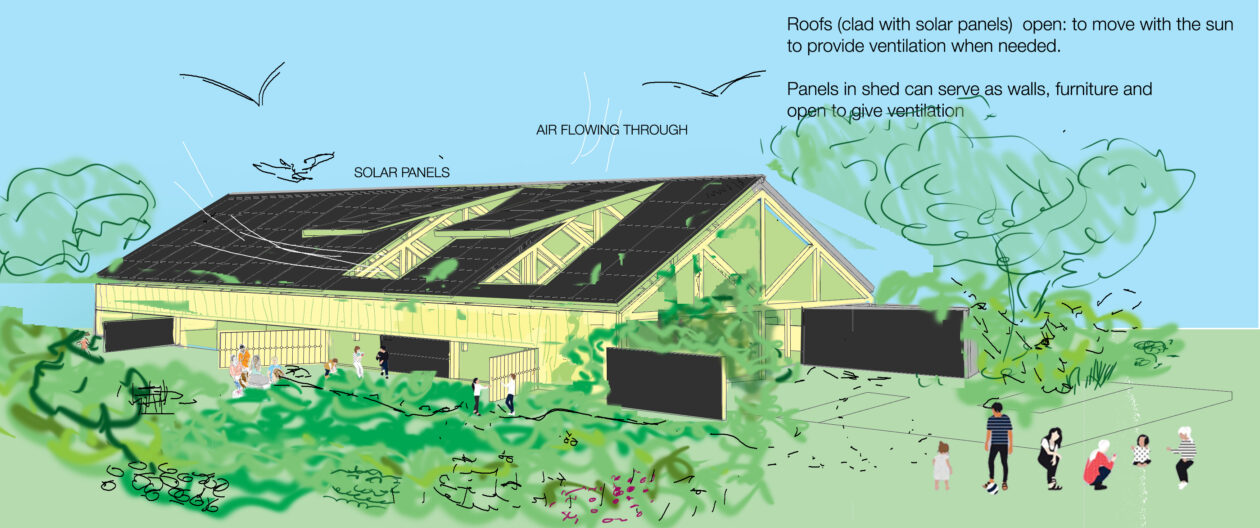
Competitions — Past
In a Rome deserted by tourists, when traveling was difficult but allowed right after Covid, I found myself on an empty bench on the Piazza Navona right next to the ’ Fontana dei Quattro Fiumi (Fountain of the Four Rivers) — usually hidden from view by other tourists — which was designed and executed by the sculptor Cavaliere Bernini in 1651.
Rome was empty and we had all the time in the world to look at every detail carved in marble: toes, horses, robes, fish, emblems and hair on the famous baroque fountain. Our smart phone with Wikepedia was our guide.[i]
The fountains were designed for Pope Innocent X, whose palace overlooked the piazza. The fountain also was the result of a design competition for architects and artists for which Bernini was initially not invited to participate. It was suggested the sculptor had enemies because of his popularity and success. After all the Borghese family were his patron. Filippe Baldunicci, Bernini’s biographer writes in 1823:
‘[..] the Pope had designs made by the leading architects of Rome without an order for one to Bernini. Prince Niccolò Ludovisi, whose wife was niece to the pope, persuaded Bernini to prepare a model, and arrange for it to be secretly installed in a room in the Palazzo Pamphili that the Pope had to pass. When the meal was finished, seeing such a noble creation, he stopped almost in ecstasy. Being prince of the keenest judgment and the loftiest ideas, after admiring it, said: “This is a trick … It will be necessary to employ Bernini in spite of those who do not wish it, for he who desires not to use Bernini’s designs, must take care not to see them.” [ii]
The reaction of the pope to Bernini’s model is one we all hope to illicit from jury members when we submit a competition. For them to stop in ecstasy and to only succeed in denying its beauty by not seeing it.
When I searched more I found Architectural competitions have a long history. The first competition being held in 448 BC for the design of the Parthenon.[iii]
Other buildings that were the result of architectural competitions: the White house by James Holden, in 1792 chosen from 9 entries and the houses of parliament, in 1835 by Charles Barry chosen from 98 entries.
Jaques Cabanieu from the MIQCP [iv] , France’s body for quality of construction, writes that competitions in France serve two purposes: the client gets to choose a design rather than an architect, so is not being forced into something by the architect and it breaks the grip of what he calls the ‘star practices’ of the profession by opening up the opportunity to bid to a wider range of practices. It also gives a practice and its staff a chance to think differently about a project and push boundaries. The competition sets the level of the building that is aspired by both the architect and client which makes developing the proposal into something tangible easier. At the same time Cabanieu acknowledges that competitions are a waste of creative energy and pleads that architects should be reimbursed for their work.
Not all clients are equally serious about realising the competition result which means that the competition process and aftermath can be costly and wasteful for architects. Especially if more than 200 practices enter competitions and the process of choosing itself becomes a lottery. The Architects Journal held in May 2018 a panel discussion on the merits of competitions in ‘What’s wrong with architectural competitions’. The points Cabanieu makes are acknowledges but all panellists seemed to agree that more and more of open ideas competitions are a cheap way for clients to receive many ideas and a lot of publicity.[v] Doing competitions is expensive and labour intensive for practices. A presentation has to stir the jury members standing out between 250 other presentations.
COVID
During COVID my practice participated in many tenders and competitions and for several reasons: First of all there has been little work during COVID19 for a recently established practice without a clear identity such as mine. It is difficult to meet new clients over zoom and during lockdown: Clients who do have work will probably go with the practices they know as zoom is not the easiest platform to meet people for the first time.
The second reason is that during the early days of the lockdown, everyone was speculating on the future: the economy, communities, the workplace and the relation between the three. Doing competitions was a good way to develop ideas about the future and giving us the feeling we were equipping ourselves for a future yet unknown. Look at the amount of playful social distance proposals that have been made and ways of shielding and wearing masks. This has now turned into jobs for practices who can turn offices into safe spaces. A third reason, which builds on the second one: competitions, whether won or lost, provide a way of building up a portfolio and create a sense of direction for the practice.
Competitions — Present
Competitions were all submitted electronically, times have changed since Bernini, and while making lastminute drawings for the think 2025 competition I missed the deadline by 1 minute.
The idea for think 2025 (the idea of a new future was in the names of many competitions), a ‘thinking shed’, continued on the submission for another competition, Homes 2030, which we participating in. Despite being critical of its purpose: the solution to the housing shortage isn’t one prefab method that can be replicated forever. We therefor proposed a hybrid construction method in order for architects and communities to be able to adapt a construction system to a specific site, in a relatively short time, where small amounts of houses at the time can be built, involving communities and creating jobs.
The factories in which the houses would be constructed would also double up as ‘Carbon Free and Low Energy information centres’, providing information and guidance on the latest climate research, to invite people to contribute to the debates and to teach people in how to live carbon neutral and how to achieve it in their homes and gardens In the 1960s ‘good living’ exhibitions were held all over Europe (some countries gave even classes) to show people how to live in apartments and how to use modern bedrooms, bathrooms and furniture.
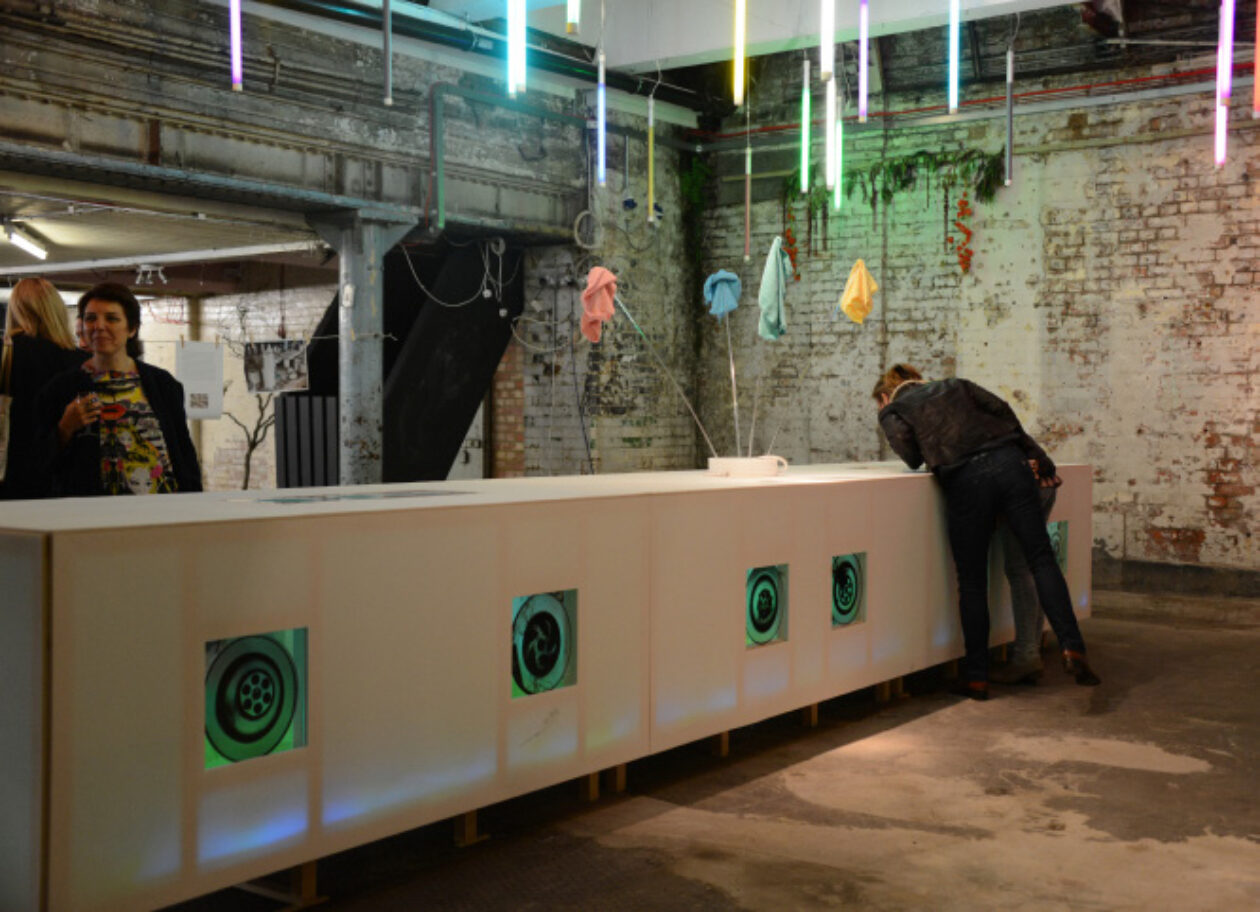
The kitchen island represents on the one hand a great love for cooking, gathering and eating. In the private environment its perfection lends some cachet to the home and therefore its owners, perhaps, a sense of control. However, on the other hand the pristine cleanliness of the island raises questions about its maintenance and the space it occupies.
It takes a good amount of cleaning and tidying up to keep up appearances. The bigger the island, the more there is to become dirty, but also the more space it occupies; as much as a medium to large sized room. Whereas this amount of storage space makes it easier to keep the modern interior clean and clutter-less, the island itself becomes populated with the clutter that is now out of sight. Does the island become a Pandora’s Box containing harmful clutter and unwanted imperfections? Or can it be used in a more constructive manner?
The Kitchen Island and its presence in the middle of a room is perhaps to the 21st century what the four poster bed must have been to the 17th century. Both define through their presence the surrounding space in the room and both represent a mixture of status, a need to display and a practical use. The largest difference between the two is that the kitchen island is used for its exterior and the four poster bed was used for its interior.
The writer Walter Benjamin criticized the bourgeois individual in Berlin and Paris, at the turn of the 20th century. This bourgeois individual could only relax and be content, be himself, in his own interior among his beloved objects in which he saw him-self reflected.
Cushioned by his objects, and therefore protected from the real world outside his room he was, ef- fectively, shutting it out. The interior and all its nostalgic objects were seen, by Benjamin, to keep the bourgeois individual captive among his possessions, preventing him from engaging with the real world and its people with its problems and challenges. The 21st century bourgeois individual, now perhaps part of the middle classes, inhabits a pristine and clutter-less interior that reflects the perfection of the life of its owners. Again the individual escapes from an engagement with the real world and the problems facing the earth and society ‑even though these enter his world on a continuous basis through handheld de- vices- hiding all clutter and waste inside a kitchen island. In fact, the kitchen island grows at the expense of the world outside it and becomes a symbol of outwards perfection only.
